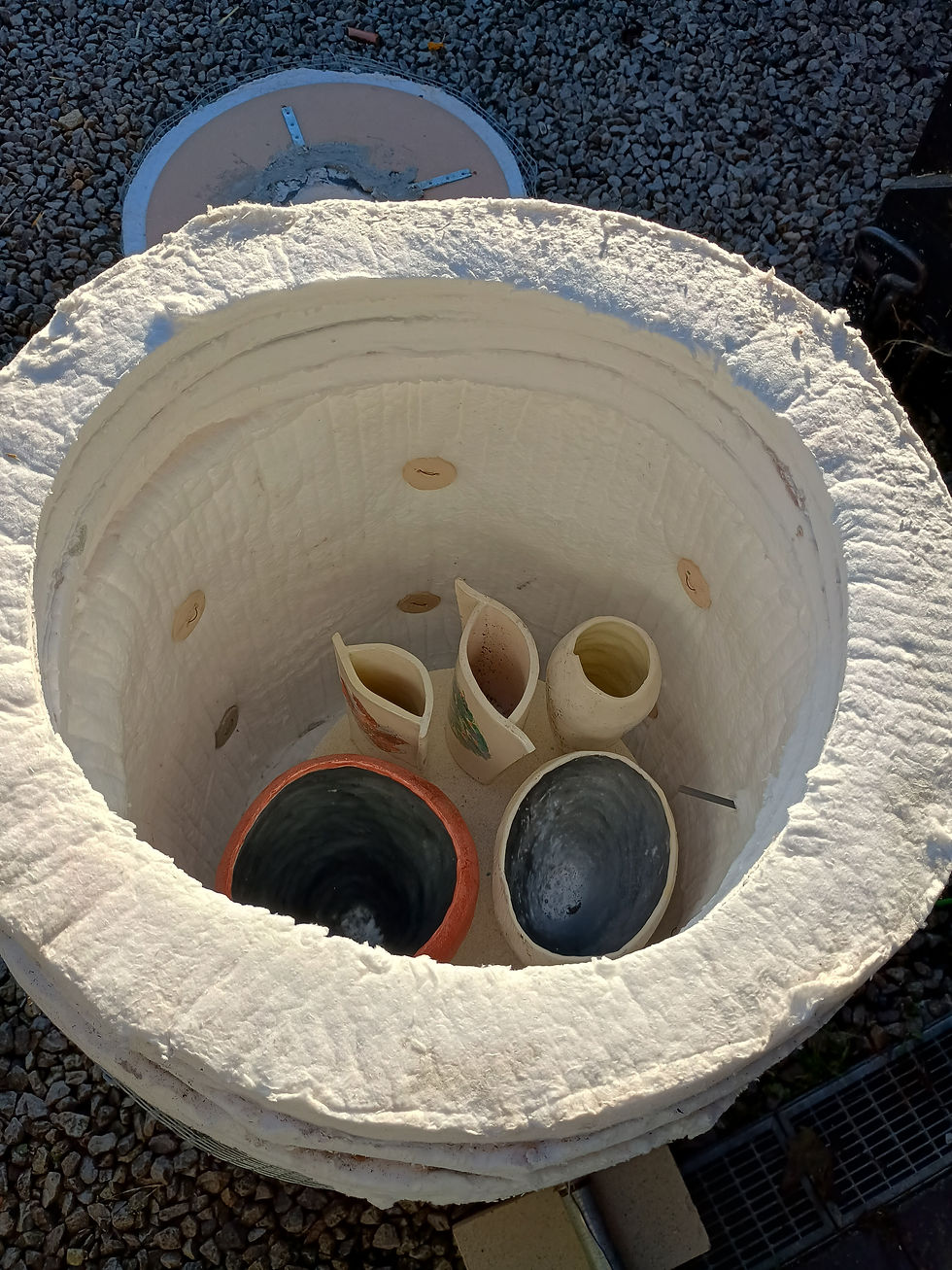A Glorious Morning for Raku
- Ian Jeffery
- Oct 24
- 4 min read

There are some mornings that seem tailor-made for Raku — crisp air, low autumn sunlight glancing across the gravel, and that quiet sense of anticipation before the first firing of the day. At our Lincolnshire barn studio, the yard was already golden with light as we set up for what promised to be a perfect session: two newly glazed vessels waiting patiently to be transformed in the kiln.
The pieces were hand-built the previous week — elegant, slightly flared forms with abstract splashes of colour at their centre. One bore a swirl of emerald and amber-green, the other a vibrant composition of orange and red, each design destined to shift and change in the flames. As always with Raku, the results would be unpredictable, but that’s half the joy.
Preparing the kiln

Our fibre-lined gas kiln stood ready on its firebricks, the burner fitted and the thermocouple wired to the digital gauge on the bricks beside it. Inside, we nestled the two vessels along with a few smaller bowls and test tiles, arranging them so the heat could circulate freely. The surface of each pot gleamed faintly under its crackle glaze — a mixture designed to craze dramatically once pulled hot from the kiln and cooled in open air.

By the time we lit the burner, the sunlight was pouring across the
workshop wall, catching the metal of the reduction bins stacked nearby. Each was filled with a generous layer of hay, ready to receive the red-hot pieces later. The smell of the dry straw mixed with the faint tang of propane as the flame settled to a steady roar. The thermometer began to climb: 200°C, 400°C, 700°C — the familiar rhythm of a Raku morning.
The dance of fire

Watching the kiln glow from within is endlessly fascinating. At around 1000°C, the colour through the spy hole deepens to a fierce orange — like looking into the heart of a star. Inside, the glazes begin to flux and melt, the oxides reacting and pooling in unpredictable ways. A gentle tapping of tongs against the kiln lid tells us it’s time. The digital readout holds steady at 1007°C.

Lifting the lid releases a rush of heat that shimmers in the morning air. For a few seconds, everything is pure light — brilliant orange forms glowing against the pale insulation. With long Raku tongs, we lift each vessel free and place it carefully into the reduction bin lined with hay. The instant they touch the straw, flames leap up, licking around the surface in a frenzy of smoke and crackle.
The moment of transformation
This is the part of the process that never loses its drama. The bright air fills with the sweet, dry smell of burning hay and the low hiss of heat meeting cool air. Quickly, we drop the metal lid over the bin and throw a damp towel on top to seal the edges. The sudden

deprivation of oxygen begins the reduction: smoke and carbon swirl around the pots, darkening the unglazed areas and forcing metallic tones into the glazes.
Within moments, the bins are alive with soft sounds — faint pops, sighs, the occasional flicker of flame escaping from a gap at the rim. The towels steam gently in the sunlight, their surface glowing a deep rust red as the heat from within works its magic. Each vessel inside is undergoing a transformation that’s part chemistry, part poetry: the glaze crackles form their signature black lines, and colours deepen in a way no brush or pigment could reproduce.
Cooling and revealing
After fifteen to twenty minutes, when the smoke begins to subside, the lids are lifted and a rush of grey vapour curls out into the air. Still glowing hot, the vessels are lifted carefully from the bins with tongs and plunged straight into a waiting bucket of cold water. The sudden shock sends up a hiss of steam and a burst of bubbling sound as the glazes set and the final network of crackles appears across the surface.
When cool enough to handle, each pot is rinsed and gently cleaned to reveal its finish. The green-and-amber piece glows like sea glass caught in sunlight, while its companion radiates fiery copper tones, each line of crazing a delicate record of the journey from flame to smoke to water.
The satisfaction of Raku
Every firing is different, and that’s what makes Raku so addictive. You can plan your glazes, watch the temperature rise, and still be surprised every single time. It’s a process that demands attention but rewards spontaneity — a dance between control and chaos, tradition and chance.
As we stood back and admired the finished pair, sunlight now slanting low across the yard, it was hard not to feel that quiet contentment that comes from a successful firing. The reduction bins were cooling, the air still faintly scented with smoke, and on the studio shelf two new pieces had found their voice.
Each vessel carries with it the memory of that morning — the warmth of the fire, the flare of flame against hay, the laughter and small shouts as the lids went on. That’s the essence of Raku: it’s not just a firing technique, it’s an experience, a celebration of imperfection and transformation.
And as we tidied away the tools and let the kiln cool for the next session, we couldn’t help but glance back at those pots, knowing that no two would ever be quite the same again.




Comments